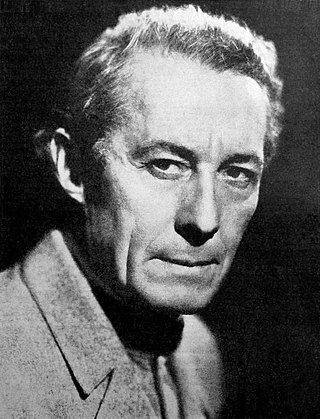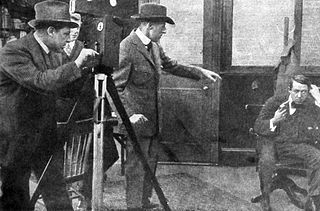Career
Dempster's first feature role came in 1919 in the Griffith directed The Girl Who Stayed at Home opposite Robert "Bobby" Harron. Dempster followed this with Griffith's The Love Flower (1920), Dream Street (1921), One Exciting Night (1922) and Isn't Life Wonderful (1924), America (1924), Sally of the Sawdust (1925), and That Royle Girl (1925). Dempster appeared opposite such notable actors as John Barrymore, Richard Barthelmess, William Powell, Ivor Novello, and W. C. Fields.
In 1926 Dempster acted in her final film, a Griffith vehicle entitled The Sorrows of Satan (1926), co-starring Adolphe Menjou, Ricardo Cortez, and the Hungarian vamp Lya De Putti. Dempster then retired from the screen to marry wealthy banker Edwin S. Larson in 1926. [1]
"Griffith made three films at Paramount's Astoria Studios, each marked by his increasing obsession with his then inamorata, another ex-Denishawn dancer named Carol Dempster...her talents have received as little respect from historians as they did at the time from her co-workers. To Griffith's biographer Richard Schickel, Dempster was a 'mildly attractive young woman' who moved well but photographed badly. Actress Louise Brooks described her as unfriendly and withdrawn. Ed Falherty, a longtime studio gaffer who observed everything and everyone from high up in the grid, remembered icily: 'she had nothing.'"—Film historian Richard Koszarski in Hollywood on the Hudson (2008). [3]
Dempster's critical stock was never very high, in part because she was unable to live up to the performances of Lillian Gish, whom she replaced as Griffith's leading lady. Her somewhat "ordinary" appearance and animated acting style were frequently criticized. [4] Also, with a few exceptions, the films she appeared in were not among Griffith's more popular works. In recent years, however, viewers and critics alike have slowly begun to appreciate her performances, particularly in two later films, Isn't Life Wonderful and The Sorrows of Satan. [5] [6]

David Wark Griffith was an American film director. Considered one of the most influential figures in the history of the motion picture, he pioneered many aspects of film editing and expanded the art of the narrative film.

Broken Blossoms or The Yellow Man and the Girl, often referred to simply as Broken Blossoms, is a 1919 American silent drama film directed by D. W. Griffith. It was distributed by United Artists and premiered on May 13, 1919. It stars Lillian Gish, Richard Barthelmess, and Donald Crisp, and tells the story of young girl, Lucy Burrows, who is abused by her alcoholic prizefighting father, Battling Burrows, and meets Cheng Huan, a kind-hearted Chinese man who falls in love with her. It was the first film distributed by United Artists. It is based on Thomas Burke's short story "The Chink and the Child" from the 1916 collection Limehouse Nights. In 1996, Broken Blossoms was included in the annual selection of 25 motion pictures to be added to the National Film Registry of the Library of Congress.

Lillian Diana Gish was an American actress. Her film-acting career spanned 75 years, from 1912, in silent film shorts, to 1987. Gish was dubbed the "First Lady of the Screen" by Vanity Fair in 1927 and is credited with pioneering fundamental film performance techniques. In 1999, the American Film Institute ranked Gish as the 17th-greatest female movie star of Classic Hollywood cinema.

The Musketeers of Pig Alley is a 1912 American short drama and a gangster film. It is directed by D. W. Griffith and written by Griffith and Anita Loos. It is also credited for its early use of follow focus, a fundamental tool in cinematography.

Robert Emmett Harron was an American motion picture actor of the early silent film era. Although he acted in over 200 films, he is possibly best recalled for his roles in the D.W. Griffith directed films The Birth of a Nation (1915) and Intolerance (1916).

Henry Brazeale Walthall was an American stage and film actor. He appeared as the Little Colonel in D. W. Griffith's The Birth of a Nation (1915).

The New York Hat is a silent short film which was released in 1912, directed by D. W. Griffith from a screenplay by Anita Loos, and starring Mary Pickford, Lionel Barrymore, and Lillian Gish.

An Unseen Enemy is a 1912 Biograph Company short silent film directed by D. W. Griffith, and was the first film to be made starring the actresses Lillian Gish and Dorothy Gish. A critic of the time stated that "the Gish sisters gave charming performances in this one-reel film". The film was shot in Fort Lee, New Jersey where early film studios in America's first motion picture industry were based at the beginning of the 20th century. Consistent with practice at that time, the actors in the cast and their roles are not listed in the film..

The Sorrows of Satan is a 1926 American silent drama film directed by D. W. Griffith, and based on the 1895 allegorical horror novel The Sorrows of Satan by Marie Corelli.

Isn't Life Wonderful is a 1924 American silent romantic drama film directed by D. W. Griffith for his company D. W. Griffith Productions, and distributed by United Artists. It was based on the short story "Isn’t Life Wonderful?" in the 1923 book Defeat by Geoffrey Moss, and it was released under the alternative title Dawn.
The One She Loved is a 1912 American silent drama film directed by D. W. Griffith. The film, by the Biograph Company, was shot in Fort Lee, New Jersey when many early film studios in America's first motion picture industry were based there at the beginning of the 20th century.
La Bohème is a 1926 American silent drama film directed by King Vidor, based on the 1896 opera La bohème by Giacomo Puccini. Lillian Gish and John Gilbert star in a tragic romance in which a tubercular seamstress sacrifices her life so that her lover, a bohemian playwright, might pen his masterpiece. Gish, at the height of her influence with Metro-Goldwyn-Mayer studios, asserted significant control over the production, determining the story, director, cast, cinematography, and costume design. In February 2020, the film was shown at the 70th Berlin International Film Festival, as part of a retrospective dedicated to King Vidor's career.
Lillian Gish in a Liberty Loan Appeal is a 1918 American silent short film directed by D. W. Griffith. Produced to support the Liberty bond drive of 1918, the film is now considered to be a lost film.

The Greatest Thing in Life is a 1918 American silent drama film about World War I, directed by D. W. Griffith and starring Lillian Gish, Robert Harron, and David Butler. The film is now considered lost as no prints are known to exist.

A Romance of Happy Valley is a 1919 American drama film directed by D. W. Griffith and starring Lillian Gish. Believed lost for almost 50 years, a print was discovered in 1965 in the State Film Archives of the Soviet Union, which donated it to the Museum of Modern Art.

True Heart Susie is a 1919 American drama film directed by D. W. Griffith and starring Lillian Gish. A print of the film survives in the film archive of the British Film Institute. The film has seen several VHS releases as well as a DVD issue.

The Scarlet Letter is a 1926 American silent drama film based on the 1850 novel of the same name by Nathaniel Hawthorne and directed by Swedish filmmaker Victor Sjöström. Prints of the film survive in the MGM/United Artists film archives and the UCLA Film and Television Archive. The film is now considered the best film adaptation of Hawthorne's novel.

The Escape is a 1914 American silent drama film written and directed by D. W. Griffith and starred Donald Crisp. The film is based on the play of the same name by Paul Armstrong who also wrote the screenplay. It is now considered lost. The master negative of the production was destroyed in the disastrous 1914 Lubin vault fire in Philadelphia, Pennsylvania.

America, also called Love and Sacrifice, is a 1924 American silent historical war romance film. It describes the heroic story of the events during the American Revolutionary War, in which filmmaker D. W. Griffith created a film adaptation of Robert W. Chambers' 1905 novel The Reckoning. The plot mainly centers on the Northern theatre of the war in New York, with romance spliced into individual movie scenes.

Clarine E. Seymour was an American silent film actress.


















